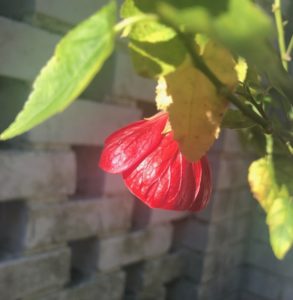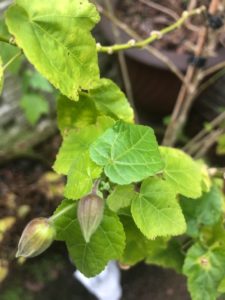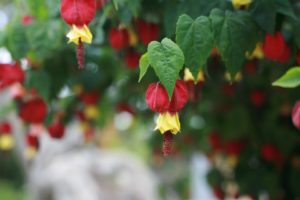
It’s not what you are thinking. This is NOT one of the 128 varieties of maple trees that might grace your landscape. This is a flowering maple and I am simply amazed! We’ve had temperatures in the teens and 20s, but this baby has taken a licking and is still ticking along with buds and blooms…in the middle of February! Yep, it’s a miracle, at least to me.
Flowering maples or abutilons are actually not maples at all. They are a member of the mallow or hibiscus family. They are also known as parlor maples because they are frequently grown indoors.
I haven’t had an abutilon in many years but last spring I spotted one at a local nursery. Of course, I had to have it. The leaves are shaped like most maple tree leaves but these are soft, almost velvety. The closed flowers resemble a parasol. As they unfurl, they look like crepe paper bells.
As a gardener and plant lover, I love the unusual. I also love that I continue to learn something almost every day. Ray Kroc, who helped build McDonald’s into an international brand said, “You are either green and growing or ripe and rotten.” So it is in the garden and for gardeners who forget that we can always learn something new.
I mention this because in trying to determine how it could be possible for my flowering maple to be flowering in February, I conducted some research. I have several ‘go-to’ sources for growing flowers or any plant. What they showed was an abutilon grows and flowers almost continuously in a Mediterranean climate.
When I think of the Mediterranean, I envision South America or New Zealand. What I found is that a Mediterranean climate is described as hot, dry summers and wet, mild winters. Also, I found that an abutilon or flowering maple is perennial in Zone 9. I am in none of those places, not in Zone 9, and the summers are hot but way more humid than dry. Wet and mild winter? Maybe that is an appropriate description.
Another gardening resource described the plant as a non-stop bloomer from spring through fall and ‘to make sure you bring it indoors before the last frost.’ But this is February and we have experienced several hard freezes and bouts with winter precipitation. My abutilon is right out there enduring it all and not only blooming but thriving. It has new leaf growth, buds developing, and flowers.
as a non-stop bloomer from spring through fall and ‘to make sure you bring it indoors before the last frost.’ But this is February and we have experienced several hard freezes and bouts with winter precipitation. My abutilon is right out there enduring it all and not only blooming but thriving. It has new leaf growth, buds developing, and flowers.
So what gives? The only answer I have is that it is somewhat protected by a brick wall on one side and a latticed brick wall on the other. Also, just maybe my green thumb is greener than I thought. For whatever reason, I love looking outside my patio door and seeing the blooms every day when all around is cold and gray. What a pick me up!
 This is how my abutilon looks in summer. The leaves are much bigger and greener in warm weather and the flowers are prolific. I feed it with a water soluble fertilizer about once a month and water it almost every day. No need for deadheading. The spent blooms fall to the ground.
This is how my abutilon looks in summer. The leaves are much bigger and greener in warm weather and the flowers are prolific. I feed it with a water soluble fertilizer about once a month and water it almost every day. No need for deadheading. The spent blooms fall to the ground.
Abutilons are available in red, yellow, pink, and orange. The one variety I long for is the Megapotamican. The flowers are a stunning combination of red and yellow. While it may be difficult to find abutilons at your local nursery or garden center, they are worth the search. Who knows, maybe you’ll get lucky and yours will bloom year-round. I would suggest putting them in a large container and perhaps bring them inside for a respite if the temperatures drop below 20 for more than a few days.
lucky and yours will bloom year-round. I would suggest putting them in a large container and perhaps bring them inside for a respite if the temperatures drop below 20 for more than a few days.
Enjoy the dreams of spring that lie ahead!
